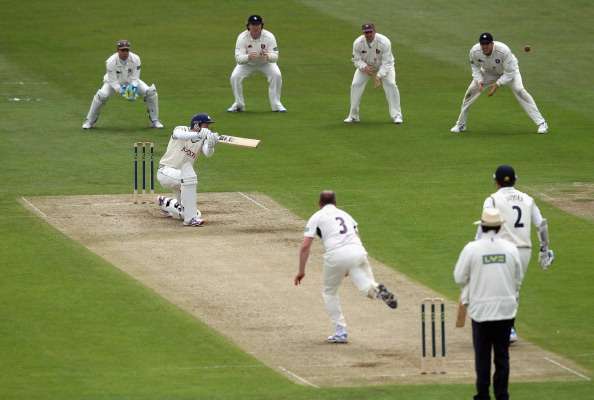Derek Pringle looks at the impact of the scrapping of the toss. Will pace and spin come back and erase those dibbly dobbers?
It was Graham Gooch who publicly admitted he was a useless tosser, after a run of bad calls as England captain in the 1990s. This season, county captains won’t entirely be able to avoid the sobriquet though they will only flip the coin in four-day cricket if both teams want to bat first, a desire rarely considered last year.
Handing the visiting captain the choice of fielding first is one of those social experiments beloved of the England and Wales Cricket Board.
Apart from trampling on tradition, this one has several well-intended goals in mind, which sounds like they are not confident of achieving a single excellent outcome and are keeping their options open as a result.
The main object of the exercise is to drive up the standards of pitches, ensuring they start dry. The idea behind this is two-fold – that it will encourage spinners to be more relevant, and it will reduce the predominance of medium-pace seamers, the Japanese knotweed of English cricket.
By starting with dry pitches, they are more likely to break up due to the physical characteristics of the soil, and because the game is likely to go on longer, another element aiding the wear and tear of the surface.
Too often last season pitches for four-day cricket began damp with the home side packing the team with seamers and risking the 50-50 outcome of the toss. Spinners were often a luxury adornment, used to bowl that odd over before a break and to keep it tight when seaming options had been exhausted. Match-winners they were not… match winners they ain’t. This is not a new phenomenon but with the number of good spinners dwindling to dangerously low levels,
it was thought something should be done before the species reached the point of no return.
There is another outcome desired by the social architects and that is by reducing the number of medium-pacers, batsmen, especially in Division Two, might actually experience something akin to international cricket – not just through increased exposure to spin, but in facing aggressive fast bowlers using bouncers to work a wicket.
Last year it was possible to watch entire sessions of county cricket without seeing a bouncer bowled,
such was the juicy nature of the pitches and the potency of the dobbers on them. After all, why employ a 90mph plus fast and nasty, or a spinner, when Darren Stevens can bowl all day, pick up five for spit, and lengthen your batting line-up to boot?
Lovers of watching spin bowlers whirr away, and of seeing batsmen duck and dive a bit, will be eager to see how it pans out though coaches keen for those skills sets to be utilised warn that the experiment must be given sufficient time to take effect. Too often in the past, aspects of the game have been tinkered with, but then ditched after just one season.
Take 1987, the year the TCCB (as ECB then was) reintroduced uncovered pitches, but only within the hours of play. Even then only 20 yards were exposed to the elements – not the run-ups and creases – so bowlers had sure footing at least until they hit their follow-through.
Notts won the County Championship that year with Richard Hadlee taking 97 wickets, but the trial was canned probably due to the amount of games spoiled by the weather. Essex drew 17 of their 24 games to finish 12th, their lowest finish during my 15 years at the club – and we never played for draws. But it would have been interesting to see how it might have panned out in a drier year.
Then in 1990, in a response to the dominance shown by seamers and swingers from their use of the Reader ball and its proud seam, the TCCB brought in two changes – a ball with reduced twine in the seam; and the strict instruction that groundsmen should produce ‘straw-coloured pitches’.
Those changes were also meant to aid spinners, but it quickly became a charter for batsmen to print runs with immediate effect. On May 3, a time when ball should still have seasonally held sway over bat, Surrey posted 707 for nine against Lancashire at the Oval, a total unheard of during my time in county cricket. Lancashire responded with 863 all out, with Surrey seeing out the draw on 70 for one at the end of day three.
By changing two variables (ball and pitch), the TCCB did not know which one had caused the most effect. When I made the point to a journalist, suggesting that as an experiment it was a bit of a cock-up, the Board fined me £250.
Needless to say bowlers struggled and both directives were canned for the 1991 season when the first four-day matches were introduced into the County Championship.
Personally, I’m all for spinners being relevant and for trundlers being forced into a reduced role, though both could co-exist if bowlers were allowed to rough up the pitches more and in more sensitive areas, with their follow-throughs.
Of course, that wouldn’t solve the lack of bouncers today’s batsmen receive, but that kind of pace and fire is unlikely to feature as large as it once did until the best international players once again frequent county cricket, increasingly unlikely since countries began to control theircricket stars through central contracts.
I always think you tinker with things at your peril, but with England not using their leading spinner, Moeen Ali, at all during the World T20 final in India – presumably because his captain lacked confidence in him doing the job at such a crucial time – something has to be done – and partially dispensing with the toss is this year’s measure.
Heads it works, tails it doesn’t.
This piece originally featured in The Cricket Paper, Friday April 8 2016















